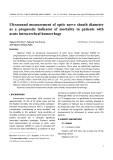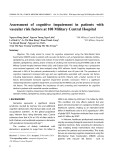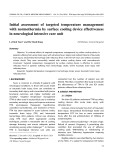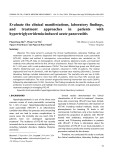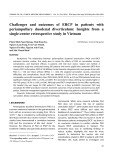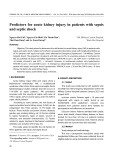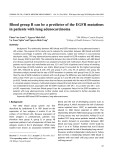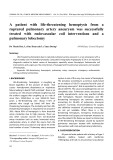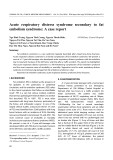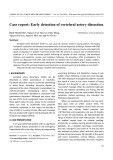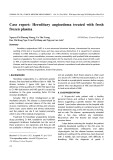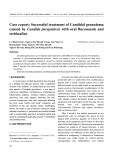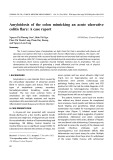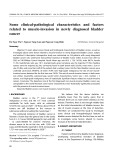Effect of magnesium ions on the activity of the cytosolic NADH/cytochrome c electron transport system Gianluigi La Piana1, Vincenza Gorgoglione1, Daniela Laraspata1, Domenico Marzulli2 and Nicola E. Lofrumento1
1 Department of Biochemistry and Molecular Biology, University of Bari, Italy 2 Institute of Biomembranes and Bioenergetics (IBBE - CNR), University of Bari, Italy
Keywords cytosolic NADH oxidation; magnesium ions and mitochondrial membrane permeability; mitochondria, cytochrome c and apoptosis; mitochondrial contact sites and respiration; mitochondrial membrane potential
Correspondence N. E. Lofrumento, Department of Biochemistry and Molecular Biology, University of Bari, via Orabona 4, 70126 Bari, Italy Fax: +39 80 5443317 Tel: +39 80 5443325 E-mail: e.lofrumento@biologia.uniba.it
(Received 25 July 2008, revised 5 September 2008, accepted 14 October 2008)
doi:10.1111/j.1742-4658.2008.06741.x
Cytochrome c (cyto-c), added to isolated mitochondria, activates the oxida- tion of extramitochondrial NADH and the generation of a membrane potential, both linked to the activity of the cytosolic NADH/cyto-c electron transport pathway. The data presented in this article show that the protec- tive effect of magnesium ions on the permeability of the mitochondrial outer membrane, supported by previously published data, correlates with the finding that, in hypotonic but not isotonic medium, magnesium pro- motes a differential effect on both the additional release of endogenous cyto-c and on the increased rate of NADH oxidation, depending on whether it is added before or after the mitochondria. At the same time, magnesium prevents or almost completely removes the binding of exoge- nously added cyto-c. We suggest that, in physiological low-amplitude swell- ing, magnesium ions may have the function, together with other factors, of modulating the amount of cyto-c molecules transferred from the mitochon- drial intermembrane space into the cytosol, required for the correct execu- tion of the apoptotic programme and/or the activation of the NADH/ cyto-c electron transport pathway.
in liver mitochondria of the
Abbreviations cyto-b5, cytochrome b5; cyto-c, cytochrome c; FCCP, carbonyl cyanide p-(trifluoromethoxy)phenylhydrazone; ferrocyto-c, ferrocytochrome c; MIM, mitochondrial inner membrane; MIS, mitochondrial intermembrane space; MOM, mitochondrial outer membrane; TMPD, N,N,N¢,N¢-tetramethyl-p-phenylenediamine; DYm, mitochondrial membrane potential change.
FEBS Journal 275 (2008) 6168–6179 ª 2008 The Authors Journal compilation ª 2008 FEBS
6168
The oxidative and energetic metabolism of glucose requires cytosolic NADH to be oxidized by the respi- ratory chain to gain the maximal production of ATP and to regenerate the cytosolic NAD+ necessary for continuous and efficient glycolytic flux. In mammalian cells, because of the impermeability of the mitochon- drial inner membrane (MIM) to pyridine nucleotides, many translocating pathways are available that may be involved in the transfer of reducing equivalents from the cytosol to the mitochondrial matrix, and vice versa [1]. Among them, two shuttle systems are the a-glycerophosphate and malate– well known: aspartate shuttles. All the proposed systems, however, promote an indirect transfer of reducing equivalents from cytosolic NADH to either NAD+ or flavopro- teins inside the mitochondria. Starting from the obser- vation that isolated mitochondria oxidize NADH present outside the mitochondria only if cytochrome c (cyto-c) is also added to the incubation medium, and supported by many converging data, we proposed the existence cytosolic NADH/cyto-c electron transport pathway in addition to and independent of the electron pathway of the respiratory chain [2–7]. In the presence of a catalytic
G. La Piana et al.
Magnesium ions and cytosolic cytochrome c oxidation
cyto-c outside the mitochondria, (a) [2–6,8–10]:
the the criticism that
sites’
a considered approaches, direct liver
the amount of NADH/cyto-c system promotes the oxidation of externally added NADH molecules; (b) the consumption of molecular oxygen by cytochrome oxidase; and (c) the generation of an electrochemical membrane potential. We have shown that some com- ponents of this additional electron transport chain are sited on the ‘respiratory contact [5,6], but endogenous cyto-c, present in the mitochondrial inter- membrane space (MIS), is not involved in this process [3]. With no knowledge of our series of publications and therefore independent of our data, a report in late 2005 [11], with the support of detailed experimen- tal interaction between the voltage-dependent anion channel and cytochrome oxidase. The existence of ‘a novel type of contact site’ as such, but with no specific function, was inferred and outlined in a scheme very similar to that reported in our paper published at the beginning of 2005 [6]. The NADH/cyto-c electron transport sys- tem may have the function, in the physio-pathological conditions associated with the extra formation of cytosolic NADH, to promote its oxidation by the direct transfer of reducing equivalents to cytochrome oxidase and the generation of an electrochemical pro- ton gradient [3]. In apoptotic cells, with the impair- ment of the respiratory chain because of the transfer of cyto-c from the mitochondria to the cytosol, the activity of the system may represent an additional, but necessary, source of energy required for correct execution of the death programme.
those present
prerequisite to study the activity of the respiratory chain, but becomes mandatory for the new, additional and independent NADH/cyto-c electron transport sys- tem to counteract results obtained can be ascribed to damaged or broken mito- chondria. One test, based on the determination of sul- fite/cyto-c oxido-reductase activity, is highly specific for measurement of the permeability of MOM to exogenous cyto-c, but requires the presence of sulfite oxidase in MIS. This enzyme is highly expressed in liver, barely in heart and absent in skeletal muscle [12]. The rotenone-insensitive NADH/cyto-c oxido- reductase activity is 10 times lower in the heart than [13]. The NADH/cyto-b5 complex of in rat MOM is responsible for the reduction of exogenous cyto-c, and therefore its activity should not be a limit- ing factor for the oxidation of cytosolic NADH. With the support of the four tests in our laboratory, we routinely utilize mitochondrial preparations containing more than 98% of mitochondria with MIM not per- meable to exogenous NADH and with MOM not per- meable to both endogenous and exogenous cyto-c. In support of the intactness of MOM, adenylate kinase and sulfite oxidase, present in MIS, are not released outside the mitochondria. Recently, unexpected new findings have shown that exogenous cyto-c does not permeate into MIS even when mitochondria are incu- bated in a strongly hypotonic medium [7]. However, some authors maintain that the NADH/cyto-c system is catalysed by broken and/or damaged mitochondria, on the basis of the observation that magnesium ions, added to mitochondria incubated in a hypotonic med- ium, promote the oxidation of exogenous NADH even in the absence of externally added cyto-c [8–10]. The possibility that the free molecules of endogenous cyto- c present in the intermembrane space may have the additional function (proposed in 1969 [14] and invoked in 1981 [15] and 2002 [16]) to shuttle electrons between the cyto-b5 of MOM and the cytochrome oxi- dase of MIM is in contrast with the already men- tioned and well-known finding that intact mammalian mitochondria are unable to oxidize exogenous NADH unless cyto-c molecules are also present outside the mitochondria.
and to measure
FEBS Journal 275 (2008) 6168–6179 ª 2008 The Authors Journal compilation ª 2008 FEBS
6169
With the support of the above-mentioned results indicating that, even with mitochondria incubated in hypotonic medium, cyto-c present outside the mito- chondria is not permeable through MOM [7], we car- ried out a series of experiments to ascertain the role and effect of magnesium ions on the activity of the cytosolic NADH/cyto-c electron transport system of mitochondria incubated in isotonic 250 mm sucrose and hypotonic 25 mm sucrose media. To date, the components identified and involved in the cytosolic NADH/cyto-c electron transport path- way are as follows: NAD-dependent dehydrogenases present in the cytosol; cytosolic NADH; the rotenone- insensitive NADH/cytochrome b5 (cyto-b5) complex present on the external leaflet of the mitochondrial outer membrane (MOM); cyto-c molecules present outside the mitochondria but not in MIS; the respiratory contact sites between the two mitochondrial membranes in which the voltage-depen- dent anion channel or porin of MOM is juxtaposed to the cytochrome oxidase molecules spanning MIM. All of these components are required for the correct exe- the cytosolic NADH/cyto-c system. The cution of activity of this electron transport pathway was studied and characterized essentially in liver mitochondria as, over time, we devised and improved four different tests for these mitochondria (see Materials and meth- ods, and [7]) to evaluate the intactness of the two their mitochondrial membranes permeability to both exogenous NADH and cyto-c. The integrity of isolated mitochondria is a necessary
G. La Piana et al.
Magnesium ions and cytosolic cytochrome c oxidation
Results
Magnesium stimulates the NADH/cyto-c system only in mitochondria incubated in hypotonic medium
Fig. 1. Effect of magnesium ions on exogenous NADH oxidation by mitochondria incubated in isotonic and hypotonic media. Rat liver mito- chondria (3 mg protein) were incubated in 3.0 mL of isotonic (traces a, b) or hypotonic (traces c–e) medium containing 250 and 25 mM sucrose, respectively, plus 20 mM Hepes (pH 7.4), 6 lM rotenone and 6 lM myxothiazol. After 2 min of incubation, 0.2 mM NADH (N) was added. Further additions: 10 lM cytochrome C (C); 4 mM MgCl2 (Mg); 1 mM potassium cyanide (CN). In trace a, when present, and in trace d, magnesium ions were added to the medium before mitochondria. The traces reported are representative of 12 obtained with nine differ- ent mitochondrial preparations, and the values reported are the number of nanomoles of NADH oxidized per minute per milligram of protein. Statistical significance in hypotonic medium: P = 3.7 · 10)8 (value 5 of trace d versus value 1.2 of trace e); P = 2.5 · 10)4 (value 9 of trace e versus value 5 of trace d); P = 8.8 · 10)5 (value 24 of trace d versus value 45 of trace e).
FEBS Journal 275 (2008) 6168–6179 ª 2008 The Authors Journal compilation ª 2008 FEBS
6170
hypotonic medium (25 mm sucrose; Fig. 1, traces c–e) oxidized exogenous NADH before the addition of cyto-c, even if at a very low rate, which was increased about eight times by magnesium ions (Fig. 1, trace e). The oxidation rate was further increased by the subse- quent addition of cyto-c, but reached a value similar to that obtained in the absence of magnesium (Fig. 1, trace c). Moreover, when MgCl2 was already present in the medium, before the addition of mitochondria (Fig. 1, trace d), NADH oxidation was higher than in the control, but, on addition of cyto-c, it was signifi- cantly lower than that obtained either in the absence (Fig. 1, trace c) or presence of magnesium added after the mitochondria (Fig. 1, trace e). Magnesium added to the isotonic medium before the mitochondria had no effect on the rate of NADH oxidation (Fig. 1, trace a). The results illustrated in Fig. 1 are consistent, at least in part, with those already reported in recent years by two research groups [8–10], showing that the exogenous NADH/cyto-c oxidation rate is greatly increased in hypotonic medium. As a new finding, not reported previously, we have shown that, in hypotonic Returning to an experiment similar to that carried out in 1989 and reported in [2], Fig. 1 (trace a) shows the property of isolated rat liver mitochondria, incubated in isotonic 250 mm sucrose medium, to promote the oxidation of exogenously added NADH in the pres- ence of respiratory chain inhibitors (rotenone and myxothiazol) and a catalytic amount of exogenous cyto-c. To test the effect of magnesium ions and avoid any interference or synergistic activity of other sub- stances, an incubation medium simply consisting of sucrose and buffer to stabilize the pH was utilized. Figure 1 (trace a) also shows that the oxidation rate was blocked by cyanide, suggesting the involvement of cytochrome oxidase. The addition of 4 mm MgCl2 before the cyto-c (Fig. 1, trace b) did not influence the NADH oxidation rate. Mitochondria incubated in
G. La Piana et al.
Magnesium ions and cytosolic cytochrome c oxidation
Magnesium-dependent binding of exogenous cyto-c and release of endogenous cyto-c stimulatory medium, magnesium has a differential effect depending on whether it is added to the incuba- tion medium before or after the mitochondria.
in both isotonic
4
The effect of Mg2+ on the distribution of both endog- enous and exogenous cyto-c of mitochondria incubated in isotonic and hypotonic media was determined in the experiments summarized in Fig. 2. The amounts pres- ent in pellets of 6 mg of mitochondrial protein, incu- bated in 6 mL of medium and then centrifuged, were determined to better appreciate the difference between each sample. As reported in Fig. 2A, we found that the content of endogenous cyto-c in the pellets of sam- ples of isotonic mitochondria stopped at zero time (i.e. immediately after the addition of mitochondria) was the same as that of samples stopped at the end of a 10-min incubation (samples, m). In addition, in sam- ples with magnesium present in the medium, the con- tent of cyto-c was the same when stopped at either 5
in the matrix space
A
The plurality and differential effects of magnesium ions on the activity of the respiratory chain, as well as on many enzymatic reactions and biological processes, have been studied extensively [17–19]. Experiments, not reported here, on the effect of Mg2+ on the oxy- gen uptake supported by succinate oxidation confirmed the results reported by Panov and Scarpa [17], and showed that magnesium, and hypotonic mitochondria, improves the ratio of state respiration; moreover, no appreciable 3/state difference was observed when added either before or after the mitochondria. In the succinate oxidation experiments, it appears that the prevailing effect of MgCl2 consists of the stabilization of ADP and ATP molecules, the substrate and product of ATP synthase activity, respectively. We have obtained indications that the effect of magnesium ions on the oxidation of substrates present (such as succinate) and catalysed by the respiratory chain is completely different from their effect on the oxidation of exogenous NADH.
B
seven different mitochondrial preparations,
Fig. 2. Effect of magnesium ions on both the content of endoge- nous cyto-c (A) and the binding of exogenous cyto-c (B) to mito- chondria incubated in isotonic and hypotonic media. Mitochondria (6 mg protein) were incubated in 6 mL of 250 mM (Iso) or 25 mM (Hypo) sucrose-based medium for a total time of 10 min (A) and 15 min (B), and then centrifuged at 10 000 g for 10 min at 4 (cid:2)C. Sequence of additions: (A) at zero time, mitochondria and the reac- tion stopped by centrifugation either immediately or at 10 min (m); at 5 min, 4 mM MgCl2 and the reaction stopped at 10 min (m-Mg); at zero time, mitochondria added to the medium already containing 4 mM MgCl2 and the reaction stopped at either 5 or 10 min (Mg-m); (B) at zero time, mitochondria, at 5 min addition of 2 lM exogenous cyto-c, and reaction stopped at either 10 or 15 min (a); alternatively, 2 lM cyto-c added at 10 min and reaction stopped at 15 min (a); at 5 min addition of 4 mM MgCl2, at 10 min addition of 2 lM cyto-c, and the reaction stopped at 15 min (Mg-c); at 5 min addition of 2 lM cyto-c, at 10 min addition of 4 mM MgCl2, and the reaction stopped at 15 min (c-Mg); 4 mM MgCl2 present in the medium, at 5 min addition of 2 lM cyto-c and reaction stopped at 15 min (Mg-m). In all samples, at 2 min, 6 lM rotenone plus 6 lM myxothiazol were added to the incubation medium. The number of nanomoles of cyto-c present in the pellets of 6 mg protein, expressed as the mean value (± standard deviation) of duplicate samples of are reported. Statistical significance: (A) **P £ 0.003 (control hypotonic versus control isotonic); *P £ 0.03 (m-Mg hypotonic versus control hypotonic); *P £ 0.02 (Mg-m hypotonic versus control hypotonic); (B) ***P £ 0.0002 (control a hypotonic versus control a isotonic); **P £ 0.002 (Mg samples in isotonic medium versus control a iso- tonic).
FEBS Journal 275 (2008) 6168–6179 ª 2008 The Authors Journal compilation ª 2008 FEBS
6171
G. La Piana et al.
Magnesium ions and cytosolic cytochrome c oxidation
or 10 min (samples, Mg-m). The same was observed with hypotonic mitochondria. Therefore, these results indicate that endogenous cyto-c is released in a rapid and complete process, and not slowly during the course of incubation. Moreover, with an isotonic med- ium, the presence of magnesium, added either before (Mg-m) or after (m-Mg) the mitochondria, did not influence the cyto-c content of the pellets. Hypotonic medium per se promotes the release of no more than 14% of cyto-c from mitochondria (m) and, in this case, the addition of magnesium after a 5-min incuba- tion of mitochondria increased to 35% the release of cyto-c compared with isotonic mitochondria (the additional release was 21%). The latter result can be considered in some aspects to be in line with the concept of the desorption mechanism proposed by Bodrova et al. [8] and supported by Lemeshko [9,10] and Scorrano et al. [16]. However, when magnesium was already present in the hypotonic medium before the addition of mitochondria (Mg-m), the release of cyto-c was significantly lower and amounted to 21% (the additional release was only 7%). The decrease in the release of cyto-c when magnesium is present in the medium recalls its protective effect (reported previ- ously [7]) on the release induced by hypotonic medium of sulfite oxidase and adenylate kinase, which, similar to cyto-c, are both present in MIS.
value of 1 nmolÆmg)1, calculated after the correction the 1.2 nmol of endogenous cyto-c, with an for increase of 2.4 times compared with isotonic mitochon- dria. It is interesting to note that the extra binding is almost completely prevented in the presence of magne- sium as, in both isotonic and hypotonic medium, 2.1 nmol of cyto-c was found in the pellets. More rele- vant is the finding that the total binding of 2.1 nmol of cyto-c (endogenous + exogenous) in both isotonic and hypotonic medium remains the same whether Mg2+ is added before (Mg-c; preventing effect) or after (c-Mg; removal effect) cyto-c. The same value of 2.1 nmol was obtained with magnesium present in the medium before the addition of mitochondria (Mg-m). However, in hypotonic medium, the binding of exo- genous cyto-c in the presence of magnesium, added either before or after cyto-c, was still higher than that in isotonic medium, with a value of 0.2 nmolÆmg)1 obtained by subtracting, from the 2.1 nmol, the value of 0.91 nmol of endogenous cyto-c reported in Fig. 2A (and divided by 6 mg of protein). The finding that the oxidation rate of exogenous NADH after the addition of cyto-c is essentially the same with the hypotonic in the absence or presence of magnesium medium, (Fig. 1, that only the traces c, e), may suggest nanomoles of cyto-c still bound in the presence of magnesium are directly involved in the activity of the NADH/cyto-c system. Notwithstanding that, in the presence of magnesium and independent of the the total binding of cyto-c sequence of additions, remains the same (Fig. 2B, Mg present), the rate of NADH oxidation is decreased to 24 nmolÆmin)1Æmg)1 (Fig. 1, trace d) with magnesium present in the med- ium, compared with a value of 45 nmolÆmin)1Æmg)1 with magnesium added after the mitochondria (Fig. 1, trace e). This may indicate that remodelling of the mitochondrial structure is involved [16,20].
Magnesium-dependent cyto-c release activates, in hypotonic medium, the NADH/cyto-c system with the generation of a membrane potential
FEBS Journal 275 (2008) 6168–6179 ª 2008 The Authors Journal compilation ª 2008 FEBS
6172
In of As reported for the first time in 1995 [3], the activity of the cytosolic NADH/cyto-c electron transport pathway is coupled, similar to the activity of the respiratory chain, to the generation of an electrochemical proton gradient determined also as the mitochondrial mem- brane potential change (DYm) [4,21]. The change in DYm generated by the NADH/cyto-c system is similar to that supported either by succinate oxidation or ATP hydrolysis [21]. The fluorimetric determination of DYm of mitochondria incubated in isotonic medium with 10 lm safranine as probe is reported in Fig. 3. As a Two experimental protocols have been designed (see Materials and methods) to analyse the effect of Mg2+ in preventing or removing the binding of exogenous cyto-c added to isolated mitochondria. The results of these experiments are reported in Fig. 2B. In the pres- ence of exogenously added 2 lm cyto-c, 3.9 nmol was found in the pellets of 6 mg of mitochondrial protein incubated in 6 mL of isotonic medium. However, not all of these molecules are of exogenous cyto-c; accord- ing to the data reported in Fig. 2A, 1.39 nmol derives from endogenous cyto-c. More precisely of the total of 12 nmol added, 2.51 nmol remains bound to mito- chondria, giving a value of 0.42 nmol bound per milli- gram of protein. The values of the supernatants (not shown) were complementary to those of the pellets in both the absence and presence of Mg2+. Magnesium added before cyto-c (Mg-c) greatly limited its binding to a value of 0.12 nmolÆmg)1, corrected for the 1.39 nmol of endogenous cyto-c. From Fig. 1 (traces a, b), it can be observed that magnesium added before or after the mitochondria does not influence the activ- ity of the NADH/cyto-c system. This may suggest that cyto-c molecules not bound in the presence of magnesium may not be involved directly in the oxidation hypotonic exogenous NADH. mitochondria, the binding capability is increased to a
G. La Piana et al.
Magnesium ions and cytosolic cytochrome c oxidation
(B) media.
Fig. 3. Mitochondrial membrane potential generated by the oxida- tion of either endogenous respiratory substrates or extra mitochon- drial NADH in isotonic (A) and hypotonic (A) Mitochondria (3 mg protein, ‘mito’) were added to 3 mL of 250 mM sucrose isotonic medium containing 0.1 mgÆmL)1 BSA, 50 lM EGTA and 10 lM safranine. (B) Mitochondria (3 mg protein) were incubated for 5 min in 3 mL of 25 mM sucrose hypotonic medium containing 6 lM rotenone, 6 lM myxothiazol, 0.1 mgÆmL)1 BSA, 50 lM EGTA and 10 lM safranine. Further additions: 6 lM rotenone plus 6 lM myxothiazol (RM); 5 lM and, only in trace c, 1 lM cyto-c (C); 166 lM NAD+(N); 45 IU alcohol dehydrogenase (A); 4 mM MgCl2 (Mg); 1.6 lM FCCP (F); 1 mM potassium cyanide (CN); 30 lM TMPD (T). In trace e, 4 mM MgCl2 was already present in the incu- bation medium before the addition of mitochondria. Experiments reported are representative of seven performed with five different mitochondrial preparations.
the mitochondria solutions. It can be observed that the addition of cyto-c promotes a nonspecific change in fluorescence, which is proportional to the amount of cyto-c added and is not abolished by uncouplers, and therefore was electrically reset down. Figure 3 (trace a) also shows that the uncoupler carbonyl cyanide p-(trifluoromethoxy)phen- ylhydrazone (FCCP) dissipates DYm, supported by the oxidation of NADH present outside the mitochondria. Dissipation of the membrane potential can also be obtained with the addition of cyanide (Fig. 3, trace b). These results confirm that the fluorescence signal is the expression of an electrical charge gradient between the outside and inside of the mitochondria, and that cyto- chrome oxidase is involved in this process. Moreover, the experimental approach in Fig. 3 mimics in vitro the generation of cytosolic NADH, as well as the activa- tion of the NADH/cyto-c system when, in physio-path- ological conditions (e.g. apoptosis), a catalytic amount of cyto-c is released from the mitochondria. Magne- sium ions added after the mitochondria, but before the activation of the NADH/cyto-c system (Fig. 3, trace b), promote a slight and sometimes not appreciable decrease in DYm linked to the oxidation of exogenous NADH. Results identical to those illustrated in Fig. 3 (trace b) were obtained when MgCl2 was added to the (not isotonic medium before reported).
FEBS Journal 275 (2008) 6168–6179 ª 2008 The Authors Journal compilation ª 2008 FEBS
6173
result of the very low electron pressure provided by the oxidation of endogenous substrates and the activity of the NADH/cyto-c system, small amounts of both BSA and EGTA were added to stabilize the membrane potential. Consistent with the previously reported data [4,21], Fig. 3 (trace a) shows that DYm, supported by the oxidation of endogenous substrates, is abolished by the addition of the respiratory chain inhibitors (rote- none and myxothiazol). The subsequent activation of the NADH/cyto-c system with the sequential addition of cyto-c, NAD+ and alcohol dehydrogenase restores DYm. With this experimental approach, NADH is con- tinuously produced outside the mitochondria by the activity of added alcohol dehydrogenase, which cataly- ses the oxidation of ethanol present in the incubation medium as the solvent of rotenone and myxothiazol Figure 3 (trace c) shows that, also with hypotonic mitochondria, the activation of the NADH/cyto-c elec- tron transport system generates a membrane potential. According to the sequence of additions, it can be seen that the generation of DYm is strictly linked to the presence of exogenous cyto-c as the electron intermedi- ate. However, with hypotonic mitochondria, a 1 lm or lower cyto-c concentration is sufficient to obtain the full expression of the membrane potential (see Fig. 3, traces a and c). It should be noted that, in Fig. 3 (traces c–f), mitochondria were preincubated for 5 min in the presence of respiratory chain inhibitors (rote- none and myxothiazol) to suppress the membrane potential generated by the oxidation of endogenous substrates (Fig. 3, traces a, b). In the presence of mag- nesium (Fig. 3, trace d), DYm was generated even with- out the addition of exogenous cyto-c, but was still sensitive to the uncoupler dissipation effect. These results are substantially consistent with those reported in [8,9]. Furthermore, as a new and original finding, Fig. 3 also shows that, if magnesium is present in the incubation medium before the addition of mitochon- dria (Fig. 3, trace e), cyto-c is required to generate DYm, similar to the results obtained in the absence of Mg2+ (Fig. 3, trace c). The comparison of the results in Fig. 3 (traces e and f) gives a clear view of the
G. La Piana et al.
Magnesium ions and cytosolic cytochrome c oxidation
lower
differential effect of magnesium ions, whether already present in the hypotonic medium or added after the mitochondria. It also provides direct evidence that, in these latter conditions, the addition of magnesium the results obtained with the addition of mimics cyto-c, the only difference being that the potential and N,N,N¢,N¢-tetramethyl-p-phenylene- is diamine (TMPD) must be added to achieve its com- plete expression. is shown that
Effect of magnesium on the two semi-reactions of the NADH/cyto-c system
(a) hypotonic mitochondria. This is an expected result if it is considered that the reaction being catalysed by the NADH/cyto-b5 complex sited on the external side of MOM occurs outside the mitochondria, and therefore should be independent of the osmolarity of the medium. In the presence of magnesium (Fig. 4, trace b), an increased rate of cyto-c reduction, usu- ally not higher than 15%, was observed in both iso- tonic and hypotonic media. In Fig. 4 (traces c and d), it the oxidation rate of exogenous cyto-c by isotonic mitochondria is not affected by the presence of MgCl2, added either before or after the mitochondria. With hypotonic mitochondria, the oxidation rate is greatly increased (Fig. 4, trace e) and magnesium decreases this rate only when present in the medium (Fig. 4, trace f), but has no effect when added after the mitochondria (Fig. 4, trace e). The data reported in Fig. 4B are consistent with and similar to those in Fig. 1 on the oxidation of exo- genous NADH as the expression of the activity of the complete system.
Discussion
The possibility that magnesium, other than having a protective effect on the permeability of mitochondria incubated in hypotonic medium (see Fig. 2 and [7]), may also directly affect the activity of the NADH/ cyto-c system was tested in the experiments reported in Fig. 4. The activity of the system was split into two main steps: the reduction of exogenous cyto-c induced by the oxidation of NADH in the cyanide-inhibited respiration (Fig. 4A); and (b) oxidation of exogenous ferrocytochrome c (ferrocyto-c) (Fig. 4B). It was found (Fig. 4A) that the NADH/ cyto-c reaction rate was similar in both isotonic and
for the functional activity,
the activity of
Fig. 4. Reduction and oxidation of exogenous cyto-c by mitochon- dria incubated in isotonic and hypotonic media. (A) Activity of rote- none-insensitive NADH-cytochrome c reductase. (B) Oxidation of ferrocyto-c present outside the mitochondria. Mitochondria (90 lg protein in A and 1.0 mg protein in B) were incubated for 5 min in 3 mL of 250 mM (Iso) or 25 mM (Hypo) sucrose-based medium con- taining 6 lM rotenone and 6 lM myxothiazol. (A) 15 lM ferricyto-c plus 1 mM potassium cyanide were also present, and the reaction was started with the addition of 0.2 mM NADH (N). (B) The reaction was started with 15 lM ferrocyto-c. Incubations were made in the absence (traces a and c) or presence of 4 mM MgCl2, added either before (traces b, d and f) or 2 min after (traces b and d) the addition of mitochondria; in trace e, magnesium was either absent or added 2 min after the mitochondria. Values on the traces represent the nanomoles of cyto-c reduced (A) or oxidized (B) per minute per milligram of protein, and are representative of eight experiments performed with five different mitochondrial preparations.
[6]. Comparing
FEBS Journal 275 (2008) 6168–6179 ª 2008 The Authors Journal compilation ª 2008 FEBS
6174
The data presented provide new insights into the role of magnesium ions in the permeability of MOM to both endogenous and exogenous cyto-c, and provide further support in liver mitochondria, of the cytosolic NADH/cyto-c electron transport system. The oxidation of exogenous NADH occurs exclusively if cyto-c is also present outside the mitochondria. It is not relevant if cyto-c is added externally, as in the case of isotonic mitochondria, or is released outside from MIS when mitochondria are incubated in hypotonic medium (Figs 1 and 2). In both cases, the system generates DYm (Fig. 3), which contradicts the interpretation that the system could represent the expression of completely broken mitochondria [8–10] and/or of mitochondria with MOM broken at leopard’s spots. This interpreta- tion is also in contrast with the finding that exogenous cyto-c is unable to react with sulfite oxidase present in MIS [7], and that dextran sulfate inhibits exogenous NADH oxidation in intact mitochondria, but not in mitoplast preparations the data reported in [7] with those in Fig. 2, it is clear that, in hypotonic mitochondria, endogenous cyto-c is released outside, although in a limited amount (14%), but cyto-c present in the medium is unable to move from outside into MIS [7]. Therefore, MOM of mitochon- dria incubated in either isotonic sucrose or very low osmotic medium (25 mm sucrose) is not broken, as generally believed, but still maintains the function of a
G. La Piana et al.
Magnesium ions and cytosolic cytochrome c oxidation
Therefore, the rates of NADH oxidation (Fig. 1) and the succinate/exogenous cyto-c reductase [7] are of both decreased greatly.
extrapolate to
protective envelope not permeable to either exogenous cyto-c or trypsin [7]. The activity of succinate/exoge- nous cyto-c reductase and the oxidation of exogenous ferrocyto-c, long proposed to be the expression of bro- ken and damaged mitochondria [22–24], are both mis- inappropriate leading the and percentage of intact mitochondria. Previously pub- lished results [5–7], and those presented in this report on the effect of magnesium ions, are consistent with the view that both the succinate/cyto-c reductase activ- ity and the oxidation rate of exogenous ferrocyto-c are correlated with the frequency of specific contact sites.
are
in the reduced state, system;
FEBS Journal 275 (2008) 6168–6179 ª 2008 The Authors Journal compilation ª 2008 FEBS
6175
The second effect is linked to the property of mag- nesium to prevent and remove the binding of exoge- nous cyto-c depending on whether it is added before or after cyto-c (Fig. 2B). In hypotonic medium, cyto-c binding increases, which tentatively could be the conse- quence of MOM stretching with the disclosure of addi- tional nonspecific binding sites. However, this increase is not responsible for the increased rate of NADH oxi- dation, as the extra binding is completely removed by the addition of magnesium, but the oxidation rate is not affected and still remains high (Figs 1 and 2B). Inhibition of the rate is observed when magnesium is already present in the medium to prevent the binding of cyto-c, which, however, is identical to the binding observed with magnesium added after the mitochon- dria or when Mg2+ is already present in the medium. Therefore, the decreased rate must be ascribed to the above-mentioned protective effect of magnesium on the structural remodelling of the two mitochondrial membranes, elicited when present in the medium (but not when added after the mitochondria), rather than to the binding of cyto-c. All of these considerations indicate that cyto-c present outside the mitochondria is essentially in the free form, available to shuttle elec- trons between the NADH/cyto-b5 reductase and the respiratory contact sites (see the scheme in [6]). How- it can be speculated that, corrected for the ever, amount of endogenous cyto-c, the 120 pmol of exo- genous cyto-c bound per milligram of protein of iso- tonic mitochondria, and insensitive to the presence of magnesium, may be the expression of the molecules tightly bound essentially to both the cytosolic side of the respiratory contact sites and the NADH/cyto-b5 reductase complex, rather than to nonspecific sites. Therefore, one possible mechanism may be that, of all the cyto-c molecules added to isolated mitochondria or present in the cytosol, only a few, in relation to the binding sites available, remain firmly bound, some to the NADH/cyto-b5 complex and some to contact sites. The majority of cyto-c molecules are free to move and, in the oxidized state (with an intermolecular process), accept electrons from reduced molecules bound to the NADH/cyto-b5 they transfer their electrons to oxidized cyto-c bound to contact sites. With hypotonic mitochondria, it can be calculated that the amount of cyto-c bound and insen- sitive to magnesium added after mitochondria is 200 pmolÆmg)1 protein. These results correlate with the differential rate of NADH oxidation by isotonic and hypotonic mitochondria reported in Fig. 1. As the With regard to the effect of magnesium on the activ- ity of the cytosolic NADH/cyto-c electron transport system, our data show a new finding, not elicited pre- viously, that magnesium presents a dual effect very clear in hypotonic but not visible in isotonic mitochon- dria. The first effect involves protection against the increase in permeability of MOM when magnesium is present in the hypotonic medium before the addition of mitochondria. Experimental data have shown that indicated as respiratory contact contact sites [5,6], sites, are the mitochondrial structures in which the the NADH/cyto-c system are main components of localized. In 1995, we defined the respiratory contact sites as dynamic but not fixed structures, which could be visualized as frequently forming and breaking bridges between different points of the inner and outer membranes; over time, the two membranes could be involved in the contact sites, forming these structures in all their parts [3]. Therefore, as a result of the much greater area of MIM than MOM, the increase in the matrix volume by hypotonic medium pushes MIM against MOM, which becomes stretched; its permeabil- ity is increased and the contact points between the two mitochondrial membranes also expected to increase. In these conditions, the oxidation rate of exogenous NADH is greatly increased (Fig. 1). If Mg2+ is added before the mitochondria, the release linked to the hypotonic medium of adenylate kinase, sulfite oxidase and endogenous cyto-c is, to a large extent, prevented relative to the findings obtained when Mg2+ is added after the mitochondria ([7] and Fig. 2), and the oxidation rate of NADH is also decreased from 45–49 to 24 nmolÆmin)1Æmg)1 (Fig. 1). Tentatively, it could be hypothesized that magnesium, with its two positive charges, may function as a linker between the negative charges of phospholipids and/or proteins. MOM and MIM become more compact, offering more resistance to the stretching caused by the the pressure induced by the increased volume of matrix. The permeability of MOM is decreased signifi- cantly, together with the frequency of contact sites.
G. La Piana et al.
Magnesium ions and cytosolic cytochrome c oxidation
the number of units per milligram of protein of NADH/cyto-b5 complex should be independent of the osmolarity of the medium, the increase in the binding of cyto-c with hypotonic mitochondria and the insensi- tivity to magnesium ions could essentially be the expression of the increased number of respiratory con- tact sites. Additional and direct experimental data are required to provide further support for these specula- tions.
the
cyto-c bound to MIM is
followed by a relevant decrease in the energy content of the cell in relation to the amount of cyto-c trans- ferred into the cytosol. This raises the problem of the energy source required for the correct execution of the in the early stages of apoptotic programme. Indeed, apoptosis, mitochondria continue to generate a mem- brane potential [25–27] which, according to some authors, can be ascribed to hydrolysis, inside the mito- chondria, of ATP generated by glycolytic activity [28]. We maintain that, in these conditions, the cytosolic cyto-c activates the NADH/cyto-c electron transport pathway, and more energy is made available for apop- totic processing before the membrane potential dissipa- tion step is activated. Indications have been obtained which support the transient participation of cyto-c in the formation of apoptosomes, as cyto-c has not been found in preparations of precipitated native apopto- somes [29] and a smaller amount of cyto-c has been found relative to that of Apaf-1 in mature apopto- somes [30]. The availability of energy, either as ATP or in the form of a membrane potential, is a prerequi- site to make apoptotic cell death a programmed and controlled process distinct from necrosis, which does not require energy as it is characterized by acute dis- ruption of cellular metabolism. Therefore, the activa- tion of the NADH/cyto-c system may represent an additional source of energy for the correct execution of the apoptotic programme. Recently, it has been reported that, in homogenates of apoptotic HeLa cells, the reduction rate of added cyto-c is lower than that in homogenates of control cells [31]. In the presence of azide, the reduction rate is increased and the values obtained are identical in both types of homogenate. The decreased rate in the reduction of cyto-c has been ascribed to an increased involvement of mitochondria present in homogenates of apoptotic cells, responsible for the oxidation of reduced cyto-c.
Data have also been reported showing that, in mice liver mitochondria, magnesium ions are involved in Bax- and Bid-induced cyto-c release [32,33]. The find- ing that magnesium ions regulate the permeability of mitochondria and the binding of cyto-c may have rele- vant implications in the bioenergetics of the cell, as well as possible consequences in therapeutic applica- tions. In tumour cells, an increase in the concentration of cytosolic cyto-c may contribute to activate the apoptotic process.
FEBS Journal 275 (2008) 6168–6179 ª 2008 The Authors Journal compilation ª 2008 FEBS
6176
The finding that MgCl2 promotes the release of an additional amount of endogenous cyto-c with hypo- tonic but not isotonic mitochondria is consistent with the view that, in physiological low-amplitude swelling, large-amplitude swelling similar to the experimental induced by hypotonic medium, contact area between the two mitochondrial membranes is increased extensively. Cyto-c molecules still bound to the exter- nal leaflet of MIM turn to face the medium and are more accessible to displacement by magnesium. This interpretation correlates with the observation that the large increase in binding of externally added cyto-c, is completely observed in hypotonic mitochondria, removed or prevented by magnesium. However, consis- tent with the desorption mechanism [8,16], the possibil- ity that removed by magnesium, and then released outside because of the increased permeability of MOM, cannot be excluded. The data presented here, together with those reported in [7], show that magnesium may have a dual role in the permeability of mitochondrial membranes: (a) it counteracts the remodelling of membrane structures induced by low-amplitude physiological swelling or, in general, by cell injury; and (b) it contributes to the correct execution of the cell death programme by pro- moting the release of cyto-c from mitochondria. In our previous publications, we have emphasized that, acti- vated by the presence of cyto-c outside the mitochon- dria, the NADH/cyto-c system may have at least two functions. The first involves the promotion, in healthy cells, of the oxidation of cytosolic NADH utilizing the mitochondrial machinery to generate ATP with the energy preserved in the membrane potential (Fig. 3). This activity becomes essential for cell survival in the presence of an impairment of the respiratory chain at the level of one of the first three respiratory complexes. The second function concerns its role in the apoptotic programme. It is well known that, in the early stages of this process, cyto-c is released into the cytosol where it participates in the formation of apoptosomes, responsible for the activation of caspases, leading to nuclear condensation and the formation of apoptotic bodies. However, the release of cyto-c from mitochon- dria promotes an impairment of the respiratory chain, Experiments are in progress in our laboratory to measure and characterize, in healthy and apoptotic HeLa cells, the activity of the cytosolic NADH/cyto-c electron transport system, and the role of magnesium ions in modulating the transfer of cyto-c from mito- chondria into the cytosol.
G. La Piana et al.
Magnesium ions and cytosolic cytochrome c oxidation
Materials and methods
above and the pellets resuspended in 1.0 mL of 50 mm Pi (pH 7.4) supplemented with 0.5% Triton X100. The cyto-c content of the pellets and supernatants was determined from a reduced minus oxidized differential spectrum in the wavelength range 500–650 nm, utilizing potassium ferricya- nide as oxidant and sodium dithionite as reductant. Spectra and kinetic determinations were carried out with Hitachi- Perkin Elmer model 557 (Hitachi, Ltd., Tokyo, Japan), Varian Cary model 50 (Varian Inc., Melbourne, Australia) and Aminco DW2A double-wavelength [modernized by OLIS (On Line Instruments Inc., Bogart, GA, USA)] spec- trophotometers.
Incubation of mitochondria
Time-dependent mitochondrial membrane potential changes (DYm) were followed fluorimetrically with a Perkin-Elmer LS-5B fluorescence luminometer, with 10 lm safranine O at wavelengths of 520 nm (excitation) and 580 nm (emission) [34].
Determination of mitochondrial membrane potential
All reagents were of analytical grade and mainly obtained from Sigma-Aldrich Chemical Co. (St Louis, MO, USA) and Roche Spa (Milan, Italy). Ferrocyto-c was prepared daily as reported in [6].
Materials
Acknowledgements
Rat liver mitochondria were isolated by differential centrifu- gation in 250 mm sucrose medium, as described previously [3]. Incubations were carried out at 25 (cid:2)C at pH 7.4 in media consisting of 20 mm Hepes/Tris and either 250 mm (isotonic medium) or 25 mm (hypotonic medium) sucrose. The intact- ness of mitochondrial membranes was routinely determined by four different but convergent and already described [7] integrity tests based on the following activities: (a) the oxida- tion of exogenously added NADH in the absence of both rotenone and exogenous cyto-c to assess the impermeability of NADH through MIM; (b) the insensitivity of intermem- brane adenylate kinase to proteolytic attack by added trypsin to reveal the increased permeability, if any, of MOM during the course of incubation; (c) the sulfite/exogenous cyto-c oxi- do-reductase activity coupled to its sensitivity to trypsin to assess the impermeability of exogenous cyto-c through MOM; (d) the succinate/exogenous cyto-c oxido-reductase activity to reveal the presence of damaged mitochondria with MIM intact but with MOM permeable to exogenous cyto-c. Mitochondrial suspensions containing no more than 2% of damaged mitochondria, according to both the NADH oxida- tion test (a) and sulfite/exogenous cyto-c test (c), were utilized (see also [7]). NADH oxidation was determined spectropho- tometrically at 340–374 nm (e = 4.28 mm)1Æcm)1) and the redox state of cyto-c at 548–540 nm (e = 21 mm)1Æcm)1) to minimize the interference of cyto-b5 sited on MOM, which has an absorbance peak at 556 nm. The protein content was determined by the biuret method.
Cyto-c content of mitochondria incubated in the absence and presence of exogenous cyto-c
The authors are grateful to Mr Francesco Felice for his skilled technical assistance. This work was sup- ported by grants from MIUR (Prin 2005–2007 ‘Bioen- ergetica: meccanismi molecolari e aspetti fisiopatologici dei sistemi bioenergetici di membrana’), CNR (Insti- tute of Biomembranes and Bioenergetics, IBBE, Bari, Italy) and University of Bari, Bari, Italy.
References
The determination of endogenous cyto-c was performed in pellets of 6 mg protein of mitochondria incubated for 10 min in 6 mL of both isotonic and hypotonic media, and then centrifuged at 10 000 g for 10 min at 4 (cid:2)C. Magnesium ions were added at a concentration of 4 mm according to the sequence of additions specified in the legend to Fig. 2.
1 Palmieri F (2004) The mitochondrial transporter family (SLC25): physiological and pathological implications. Pflu¨gers Arch 447, 689–709.
2 Lofrumento NE, Marzulli D, Cafagno L, La Piana G
& Cipriani T (1991) Oxidation and reduction of exogenous cytochrome c by the activity of the respiratory chain. Arch Biochem Biophys 288, 293–301.
3 Marzulli D, La Piana G, Cafagno L, Fransvea E &
Lofrumento NE (1995) Proton translocation linked to the activity of the bi-trans-membrane electron transport chain. Arch Biochem Biophys 319, 36–48.
4 La Piana G, Fransvea E, Marzulli D & Lofrumento NE (1998) Mitochondrial membrane potential sup-
The capability of magnesium ions to both prevent and remove the binding of exogenously added cyto-c was deter- mined in isotonic and hypotonic media with two experi- mental protocols. In the first procedure, 4 mm MgCl2 was added 5 min after the mitochondria, but before 2 lm cyto-c was added at 10 min, and the reaction was stopped at 15 min. In the second procedure, 2 lm of cyto-c was added at 5 min, 4 mm MgCl2 at 10 min and the reaction was stopped at 15 min. Details of the sequence of additions are reported in the legend to Fig. 2. To increase the reliability of the results and to better appreciate the changes induced by magnesium, mitochondria containing 6 mg of protein were incubated in 6 mL of medium, centrifuged as specified
FEBS Journal 275 (2008) 6168–6179 ª 2008 The Authors Journal compilation ª 2008 FEBS
6177
G. La Piana et al.
Magnesium ions and cytosolic cytochrome c oxidation
18 Romani AM & Scarpa A (2000) Regulation of cellular
magnesium. Front Biosci 5, D720–D734.
19 Romani A (2007) Magnesium homeostasis in mamma-
ported by exogenous cytochrome c oxidation mimics the early stages of apoptosis. Biochem Biophys Res Commun 246, 556–561.
5 Marzulli D, La Piana G, Fransvea E & Lofrumento NE
lian cells. Arch Biochem Biophys 458, 90–102.
(1999) Modulation of cytochrome c-mediated extramitochondrial NADH oxidation by contact site den- sity. Biochem Biophys Res Commun 259, 325–330.
20 Frey TG & Sun MG (2008) Correlated light and elec- tron microscopy illuminates the role of mitochondrial inner membrane remodeling during apoptosis. Biochim Biophys Acta 1777, 847–852.
21 La Piana G, Marzulli D, Irno Consalvo M & Lofru-
6 La Piana G, Marzulli D, Gorgoglione V & Lofrumento NE (2005) Porin and cytochrome oxidase containing contact sites involved in the oxidation of cytosolic NADH. Arch Biochem Biophys 436, 91–100.
mento NE (2003) Cytochrome c-induced cytosolic nico- tinamide adenine dinucleotide oxidation, mitochondrial permeability transition, and apoptosis. Arch Biochem Biophys 410, 201–221.
22 Douce R, Christensen EL & Bonner WD Jr (1972)
Preparation of intact plant mitochondria. Biochim Bio- phys Acta 275, 148–160.
7 Gorgoglione V, Laraspata D, La Piana G, Marzulli D & Lofrumento NE (2007) Protective effect of magne- sium and potassium ions on the permeability of the external mitochondrial membrane. Arch Biochem Bio- phys 461, 13–23.
23 Neuburger M, Journet E-P, Bligny R, Carde J-P &
8 Bodrova ME, Dedukhova VI, Mokhova EN & Skula-
Douce R (1982) Purification of plant mitochondria by isopycnic centrifugation in density gradients of Percoll. Arch Biochem Biophys 217, 312–323.
chev VP (1998) Membrane potential generation coupled to oxidation of external NADH in liver mitochondria. FEBS Lett 435, 269–274.
9 Lemeshko VV (2000) Mg(2+) induces intermembrane
24 Lee AC, Zizi M & Colombini M (1994) Beta-NADH decreases the permeability of the mitochondrial outer membrane to ADP by a factor of 6. J Biol Chem 269, 30974–30980.
electron transport by cytochrome c desorption in mito- chondria with the ruptured outer membrane. FEBS Lett 472, 5–8.
25 Bossy-Wetzel E, Newmeyer DD & Green DR (1998)
10 Lemeshko VV (2002) Cytochrome c sorption–desorp- tion effects on the external NADH oxidation by mito- chondria: experimental and computational study. J Biol Chem 277, 17751–17757.
11 Roman I, Figys J, Steurs G & Zizi M (2005) In vitro
Mitochondrial cytochrome c release in apoptosis occurs upstream of DEVD-specific caspase activation and inde- pendently of mitochondrial transmembrane depolariza- tion. EMBO J 17, 37–49.
interactions between the two mitochondrial membrane proteins VDAC and cytochrome c oxidase. Biochemistry 44, 13192–13201.
12 Woo WH, Yang H, Wong KP & Halliwell B (2003)
26 Goldstein JC, Waterhouse NJ, Juin P, Evan GI & Green DR (2000) The coordinate release of cyto- chrome c during apoptosis is rapid, complete and kinet- ically invariant. Nat Cell Biol 2, 156–162.
Sulphite oxidase gene expression in human brain and in other human and rat tissues. Biochem Biophys Res Com- mun 305, 619–623.
27 Waterhouse NJ, Goldstein JC, von Ahsen O, Schuler M, Newmeyer DD & Green DR (2001) Cytochrome c maintains mitochondrial transmembrane potential and ATP generation after outer mitochondrial membrane permeabilization during the apoptotic process. J Cell Biol 153, 319–328.
28 Rego AC, Vesce S & Nicholls DG (2001) The mecha-
13 Ito A (1980) Cytochrome b5-like hemoprotein of outer mitochondrial membrane: OM cytochrome b. II. Con- tribution of OM cytochrome b to rotenone-insensitive NADH-cytochrome c reductase activity. J Biochem 87, 73–80.
14 Nicholls P, Mochan E & Kimelberg HK (1969) Com-
nism of mitochondrial membrane potential retention following release of cytochrome c in apoptotic GT1-7 neural cells. Cell Death Differ 8, 995–1003.
29 Hill MM, Adrain C, Duriez PJ, Creagh EM & Martin
plex formation by cytochrome c: a clue to the structure and polarity of the inner mitochondrial membrane. FEBS Lett 3, 242–246.
15 Bernardi P & Azzone GF (1981) Cytochrome c as an
SJ (2004) Analysis of the composition, assembly kinetics and activity of native Apaf-1 apoptosomes. EMBO J 23, 2134–2145.
30 Zou H, Li Y, Liu X & Wang X (1999) An APAF-1
electron shuttle between the outer and inner mitochon- drial membranes. J Biol Chem 256, 7187–7192.
cytochrome c multimeric complex is a functional apop- tosome that activates procaspase-9. J Biol Chem 274, 11549–11556.
16 Scorrano L, Ashiya M, Buttle K, Weiler S, Oakes SA, Mannella CA & Korsmeyer SJ (2002) A distinct path- way remodels mitochondrial cristae and mobilizes cyto- chrome c during apoptosis. Dev Cell 2, 55–67.
17 Panov A & Scarpa A (1996) Mg2+ control of respira- tion in isolated rat liver mitochondria. Biochemistry 35, 12849–12856.
31 Borutaite V & Brown GC (2007) Mitochondrial regula- tion of caspase activation by cytochrome oxidase and tetramethylphenylenediamine via cytosolic cytochrome c redox state. J Biol Chem 282, 31124–31130.
FEBS Journal 275 (2008) 6168–6179 ª 2008 The Authors Journal compilation ª 2008 FEBS
6178
G. La Piana et al.
Magnesium ions and cytosolic cytochrome c oxidation
32 Eskes R, Antonsson B, Osen-Sand A, Montessuit S,
ated by a pathway independent of mitochondrial perme- ability, transition pore and Bax. J Biol Chem 275, 39474–39481.
34 Akerman KEO & Wikstrom MKF (1976) Safranine as a probe of the mitochondrial membrane potential. FEBS Lett 68, 191–197.
Richter C, Sadoul R, Mazzei G, Nichols A & Martinou JC (1998) Bax-induced cytochrome c release from mito- chondria is independent of the permeability transition pore but highly dependent on Mg2+ ions. J Cell Biol 143, 217–224.
33 Kim T-H, Zhao Y, Barber MJ, Kuharsky DK & Yin X-M (2000) Bid-induced cytochrome c release is medi-
FEBS Journal 275 (2008) 6168–6179 ª 2008 The Authors Journal compilation ª 2008 FEBS
6179





